WordPress Statistics: How Many Websites Use WordPress in 2024?
Since its inception in 2003, WordPress has dominated the CMS (content management system) market, and it now powers almost half of all websites on the Internet.
In this post, we’ll examine some eye-opening WordPress statistics that tell us more about this powerful, open-source software tool, its users, and the plugins and themes that form part of the WordPress ecosystem.
Ready? Let’s dive into it!
WordPress statistics (top picks)
- 472 million websites use WordPress, which is 43.3% of all the websites on the internet
- WordPress has a 62.7% share of the CMS market, which is more than 10x greater than its closest competitor
- 62.4% of WordPress users are running the latest version of the software (WordPress 6.5)
- 20.2% of WordPress sites and 8.8% of all websites use WooCommerce, which means there are over 163.5 million WooCommerce stores.
- WooCommerce (built on WordPress) is the world’s most popular ecommerce platform, with over 36% of the market share.
- There are over 20,000 WordPress themes, including around 11,000 free themes, in the WordPress Themes Directory.
- Divi is used on over 3.8 million websites, making it the most popular WordPress theme.
- Individual WordPress themes cost $59 and theme subscriptions cost $145 per year on average.
- There are around 60,000 free WordPress plugins on the WP plugin database
- Elementor is the most widely used free WordPress plugin, with over 10m+ installations.
How many websites use WordPress?
Around 472 million websites use WordPress as of 2024. This represents around 43.3% of all websites.
And that figure is growing rapidly. In fact, over 10,000 sites are built with WordPress every day, compared to just 60-80 on competitor platforms like Shopify and Squarespace.
This makes WordPress the world’s most widely used CMS platform and the fastest growing.
What percentage of websites use WordPress?
As of June 2024, a mindboggling 43.3% of all websites globally use WordPress.

WordPress completely dominates the market, and the closest competitor has a 10x smaller market share. But below, you can see how it compares against its main competitors, such as Shopify, Wix, Squarespace, and others.
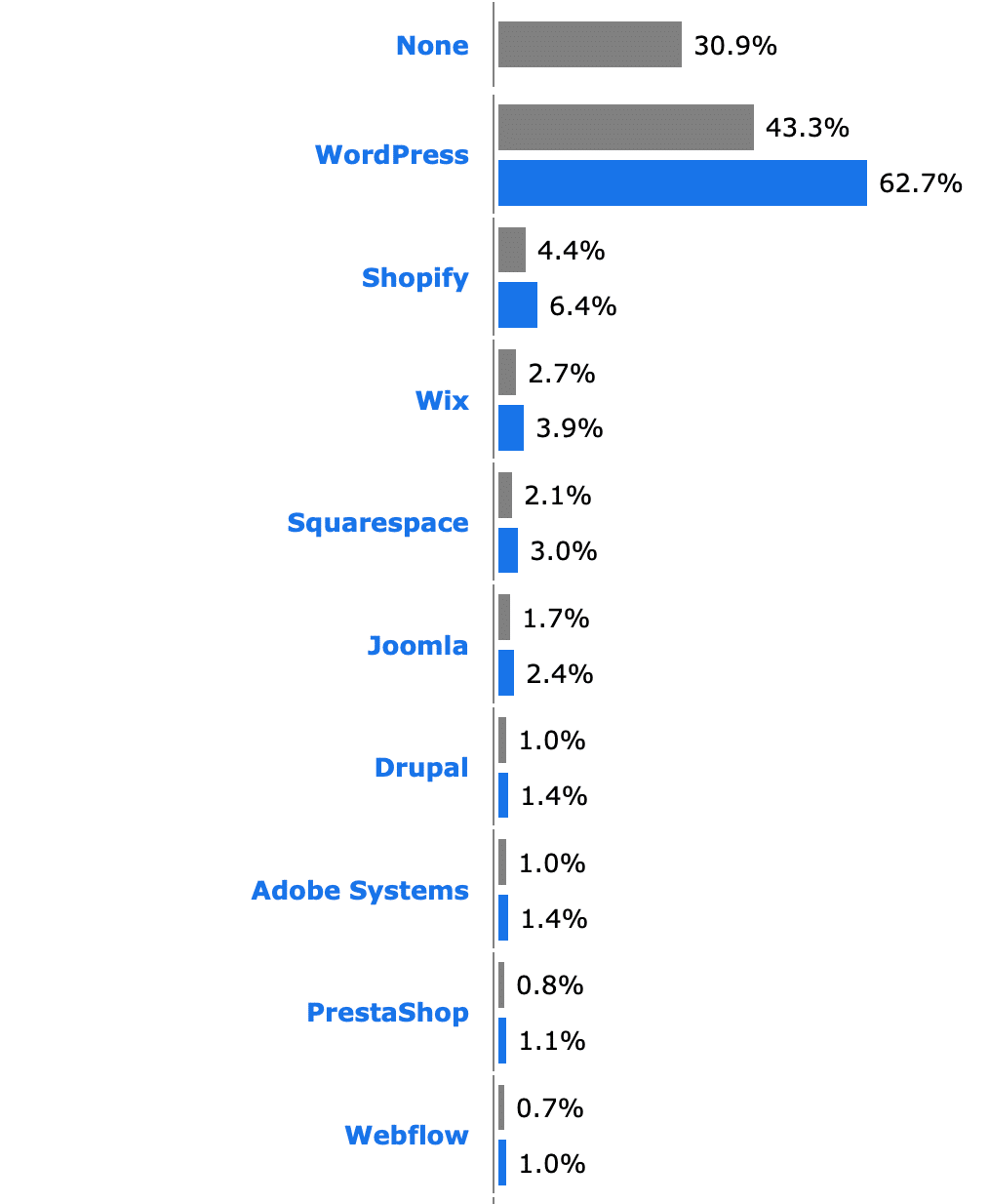
However, on the WordPress.org about page, this figure is estimated to be a little lower at 42%.
Given that there were over 1.09 billion websites online in 2024, according to Colorlib, we can calculate that the number of websites built on WordPress is around 472 million. That’s leagues away from their nearest competitor, Shopify, which powers just 4.4% of all websites (around 70 million).
| CMS | Websites (% of total) | Websites (number)* |
| WordPress | 43.3% | 472 million |
| Shopify | 4.4% | 48 million |
| Wix | 2.7% | 29 million |
| Squarespace | 2.1% | 23 million |
| Joomla | 1.7% | 18 million |
The success of WordPress can no doubt be attributed to its unparalleled versatility and extensibility.
Its open-source roots, flexible infrastructure, and huge database of plugins and themes enable developers to use WordPress to create any kind of website imaginable, from small personal blogs to complex business websites for the world’s biggest companies.
Key WordPress usage statistics:
- According to BuiltWith, 29.41% of the world’s top 10k websites use WordPress
- 29.65% of the world’s top 100k websites use WordPress
- 28.7% of the world’s top 1m websites use WordPress
- 44% of WordPress users have English (US) set as the primary language (locale).
Growth of WordPress usage over time
Historical data shows that WordPress usage has grown steadily year over year. It’s been the fastest growing CMS for over a decade, and the percentage of websites using WordPress grew by 3.7% from 2021 to 2023 alone.
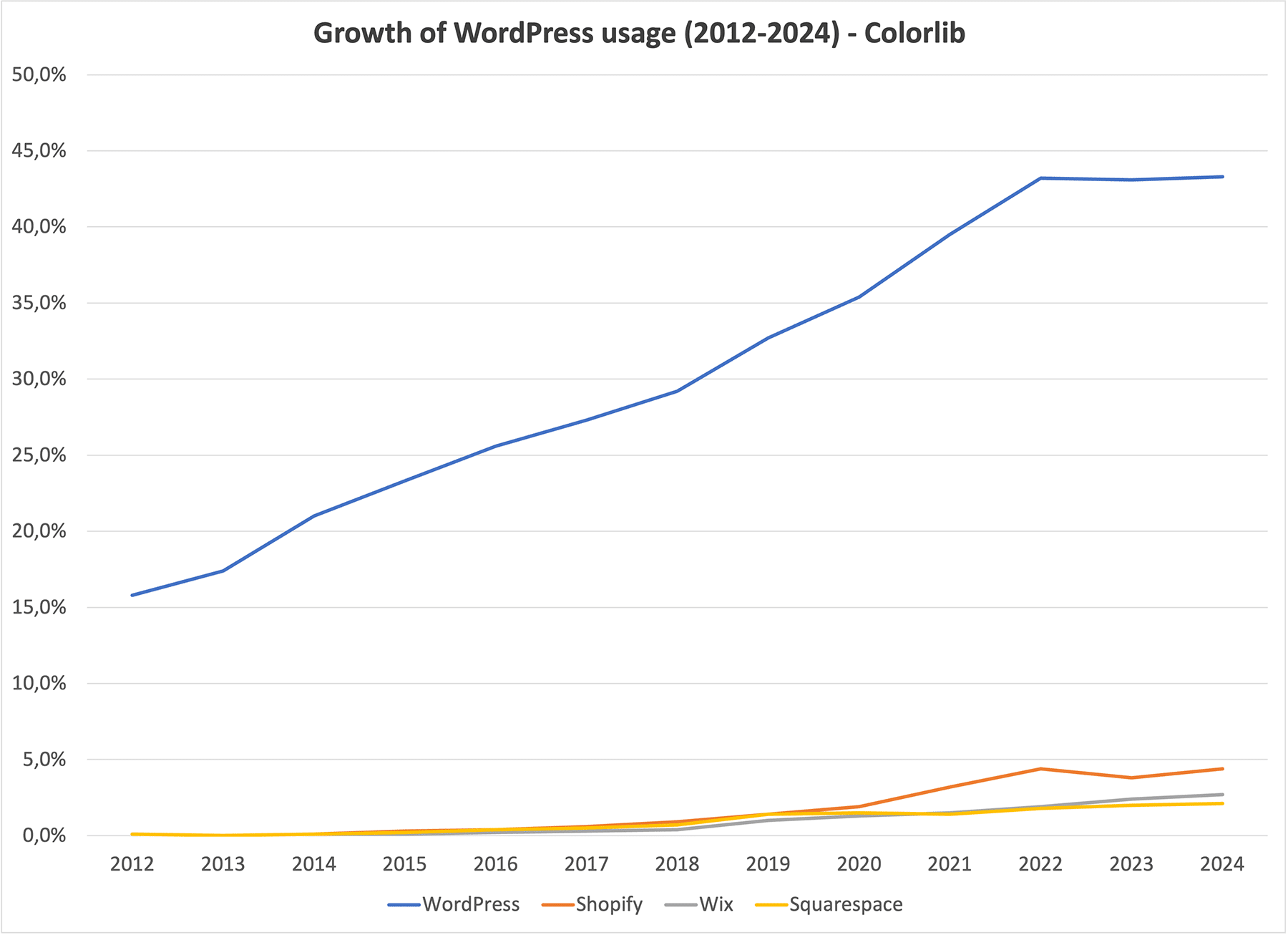
Here’s a breakdown of historical trends that illustrate this growth over time. The figures below represent the percentage of the total number of websites on the internet that are powered by WordPress each year:
10-year WordPress growth statistics:
- 2024: 43.3% (+0.2%)
- 2023: 43.1% (+0.1%)
- 2022: 43.0% (+3.7%)
- 2021: 39.5% (+4.1%)
- 2020: 35.4% (+2.7%)
- 2019: 32.7% (+3.5%)
- 2018: 29.2% (+3.5%)
- 2017: 27.3% (+1.9%)
- 2016: 25.6% (+1.7%)
- 2015: 23.3% (+2.3%)
- 2014: 21% (+2.3%)
- 2013: 17.4% (+3.6%)
While this clearly shows WordPress usage is growing, the Google Trends data tells a different story:
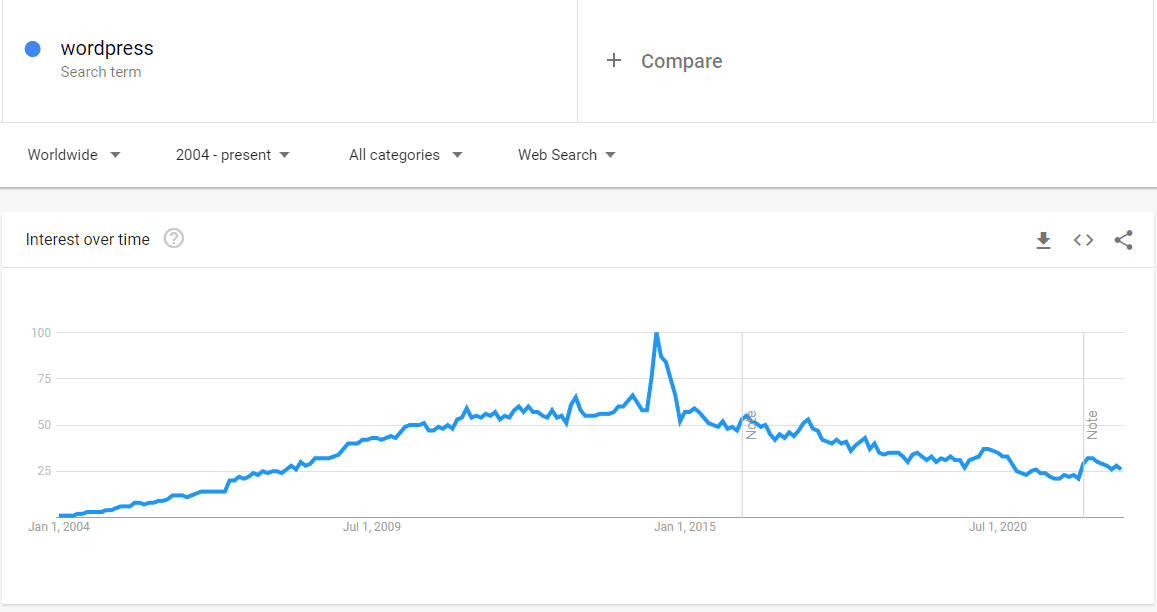
As the graph above illustrates, search interest (a metric that indicates the number of people searching for a given term on Google monthly) in “WordPress” increased steadily from 2004 until 2014. However, after peaking in July of 2014, it began falling and has dropped steadily since.
That said, it’s worth noting that search interest isn’t a reliable indicator of growth as a decline in search volume doesn’t necessarily indicate a decline in usage.
What is WordPress CMS market share?
WordPress has a CMS market share of 64.2%, almost two-thirds of the market. This makes it the clear market leader by a large margin. For comparison, WordPress’ closest competitor, Shopify, has a market share of just 6.4%
Top 5 CMS platforms by market share:
- WordPress – 62.7%
- Shopify – 6.4%
- Wix – 3.9%
- Squarespace – 3%
- Joomla – 2.4%
Sources: WordPress, W3Techs1, W3Techs2, Statista, BuiltWith, WordPress stats, Google Trends
WordPress theme statistics
WordPress themes are templates that control the way your website looks. You can add them to your WordPress site in a couple of clicks to instantly transform the design, then customize them to make them your own.
Tens of thousands of WordPress themes are available, including around 10,000 free themes in the WordPress Themes Directory and around 11,000 premium themes on Envato Elements.
The most popular themes have over 1 million downloads each. And the most popular theme of all time is Divi, which is used by over 3.8 million websites.
How many WordPress themes are there?
Currently, 11,720 free themes are listed in the WordPress Themes Directory, plus thousands more paid themes available through third-party websites. There are 11,561 premium themes for sale on Envato Elements alone.

With so many themes, it can be tough to know where to start. Here at Colorlib, we’ve compiled a repository of over 300 theme collections, which you can explore to find the best themes for every niche.
We also have over a dozen great free themes available for download on our themes page.
What are the most popular WordPress themes of all time?
Divi is the most popular WordPress theme of all time, according to BuiltWith. Over 3.8 million websites use the Divi design framework, which improves on the standard WordPress post editor and enables true visual editing.
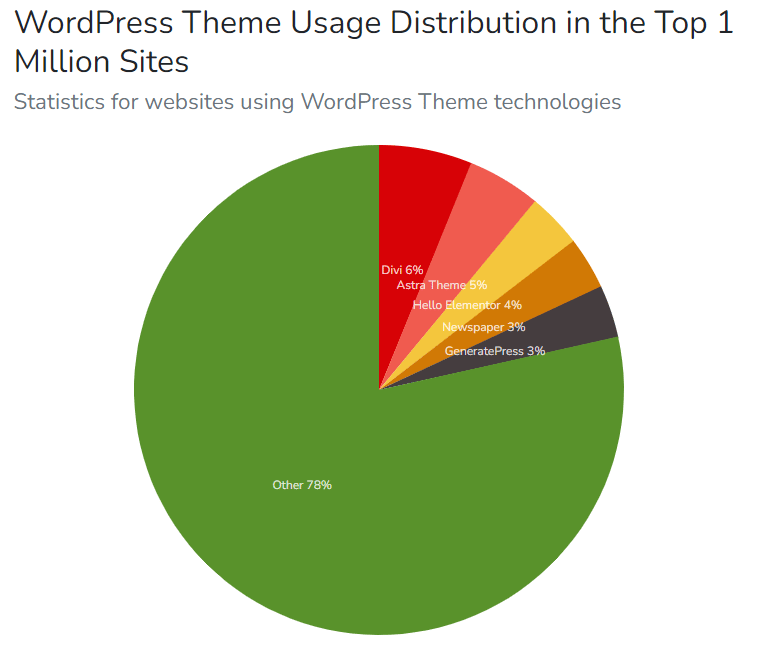
Astra—another highly customizable theme designed to work alongside page builders—is the second most used WordPress theme of all time, according to the same source. Around 3.3 million websites use it.
Newspaper – most popular news magazine WordPress theme developed by tagDiv. It has a unique Cloud Library that features over 1,300 unique starter templates and website elements making it the most customizable WordPress theme.
What is the most popular free WordPress theme?
The most popular free WordPress theme in the WordPress Themes Directory is Twenty Twenty-Four, with over 1M+ active installations and thousands of downloads daily. However, the WordPress directory stops counting at 1 million installations, so it’s tough to know the exact number.
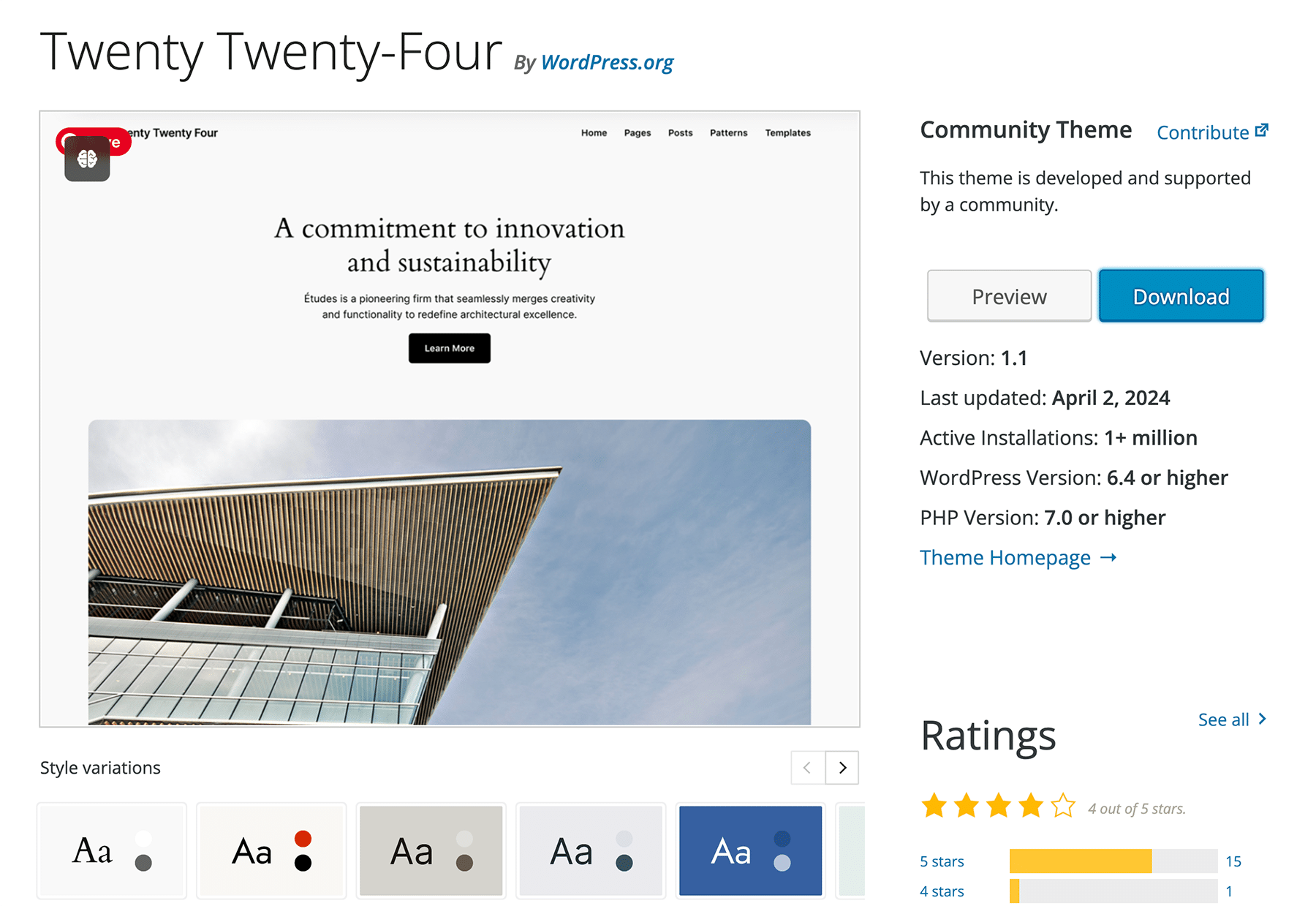
This number one spot isn’t all that surprising, given that it’s WordPress’ default theme this year and was built to take full advantage of the editing features introduced in the latest version of WordPress.
Top 10 themes in the WordPress theme directory:
- Twenty Twenty-Four: 1M+ active installations
- Hello Elementor: 1M+ installations
- Astra: 1M+ installations
- Twenty Twenty-Three: 1M+ active installations
- Twenty Twenty-Two: 1M+ installations
- Twenty Twenty-One: 1M+ installations
- OceanWP: 600k+ installations
- Kadenca: 300k+ installations
- Twenty Twenty: 700k+ installations
- GeneratePress: 400k+ installations
- Neve: 300k+ installations
What is the most popular WordPress theme on Envato Market?
Avada is the most popular theme on Envato Market, with almost 965,000 sales to date. It’s been the number-one best-selling theme on Envato for the last decade.
Top 10 paid themes on Envato Market:
- Avada – 965k sales
- The7 – 308k sales
- Betheme – 301k sales
- Enfold – 260k sales
- Flatsome – 238k sales
- X | The Theme – 225k sales
- Bridge – 210k sales
- Jupiter – 176k sales
- Salient – 152k sales
- Newspaper – 143k sales
How much do WordPress themes cost?
The average WordPress theme costs $59, according to an analysis by Codeinwp. This seems to be the sweet spot for pricing, with more premium themes clustered around this price point than any other.
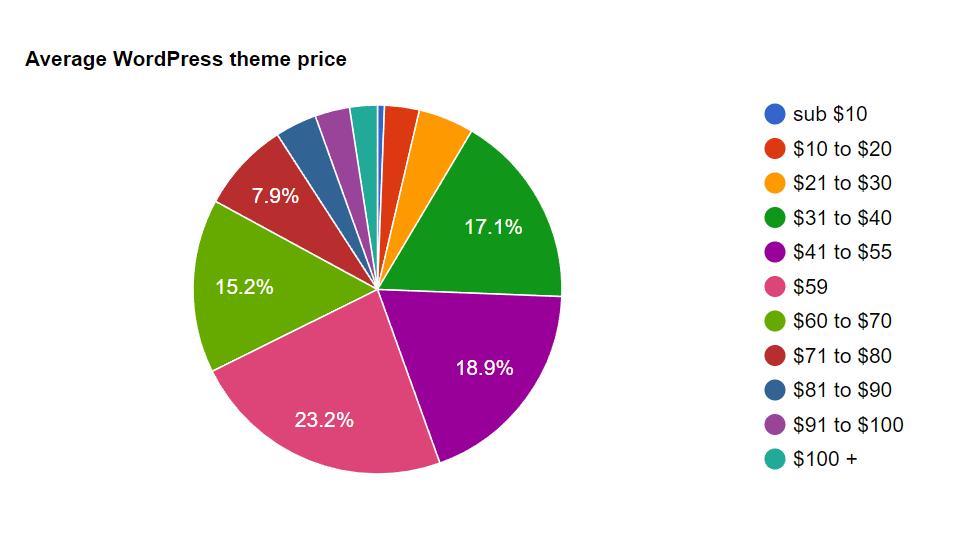
However, there is considerable variation from the low-end to the high-end of the market:
- The lowest-priced themes on Envato Market are $13
- The highest-priced theme on Envato Market is $10,000
However, themes at these kinds of price points tend to be outliers. Less than 2.4% of premium themes cost more than $100, and only 3% of themes fall in the $10-$20 range.
Many WordPress users and web design agencies prefer to buy theme club subscriptions, rather than purchase themes individually. A theme club subscription costs $145 per year or $255 for a lifetime subscription.
Other interesting WordPress theme statistics
- As of 2024, there have been 15 default WordPress themes, each named after the year of its release.
- ‘Classic’ is the earliest WordPress theme. It was the default theme for all WordPress sites pre-2005. However, it wasn’t really a true ‘theme’ in the same sense that we think of them now as it came before the introduction of the WordPress theme system.
- Kubrick was the first ever ‘official’ WordPress theme. It was released as the default theme in 2005 and was designed by Michael Hellemann.
Sources: WordPress Themes Directory, BuiltWith, Envato Market, Colorlib
WordPress plugin statistics
Next, we’ll look at some WordPress statistics related to plugins. In case you didn’t know, plugins are small software applications that run on top of WordPress. You can install and activate them on your WordPress site to extend its functionality.
How many WordPress plugins are there?
There are around 59,557 free plugins in the WordPress Plugin Directory. In addition, over 5,000 paid plugins on CodeCanyon, and many more are available on other third-party sites. We estimate that there are over 15,000 paid WordPress plugins.
This huge number of plugins is what makes WordPress such a powerful platform. It’s practically endlessly extensible, and some plugins cover any use case you can imagine. If you can think of it, there’s probably a plugin out there that can make it happen.
What is the most popular WordPress plugin?
Elementor is the most popular free WordPress plugin, with over 10M active installations. It is closely followed by Contact Forms 7, Yoas SEO, and Classic Editor. WordPress.org plugin repository reports the same active numbers for all, but Elementor still takes the crown with more installs, which is a tight battle.
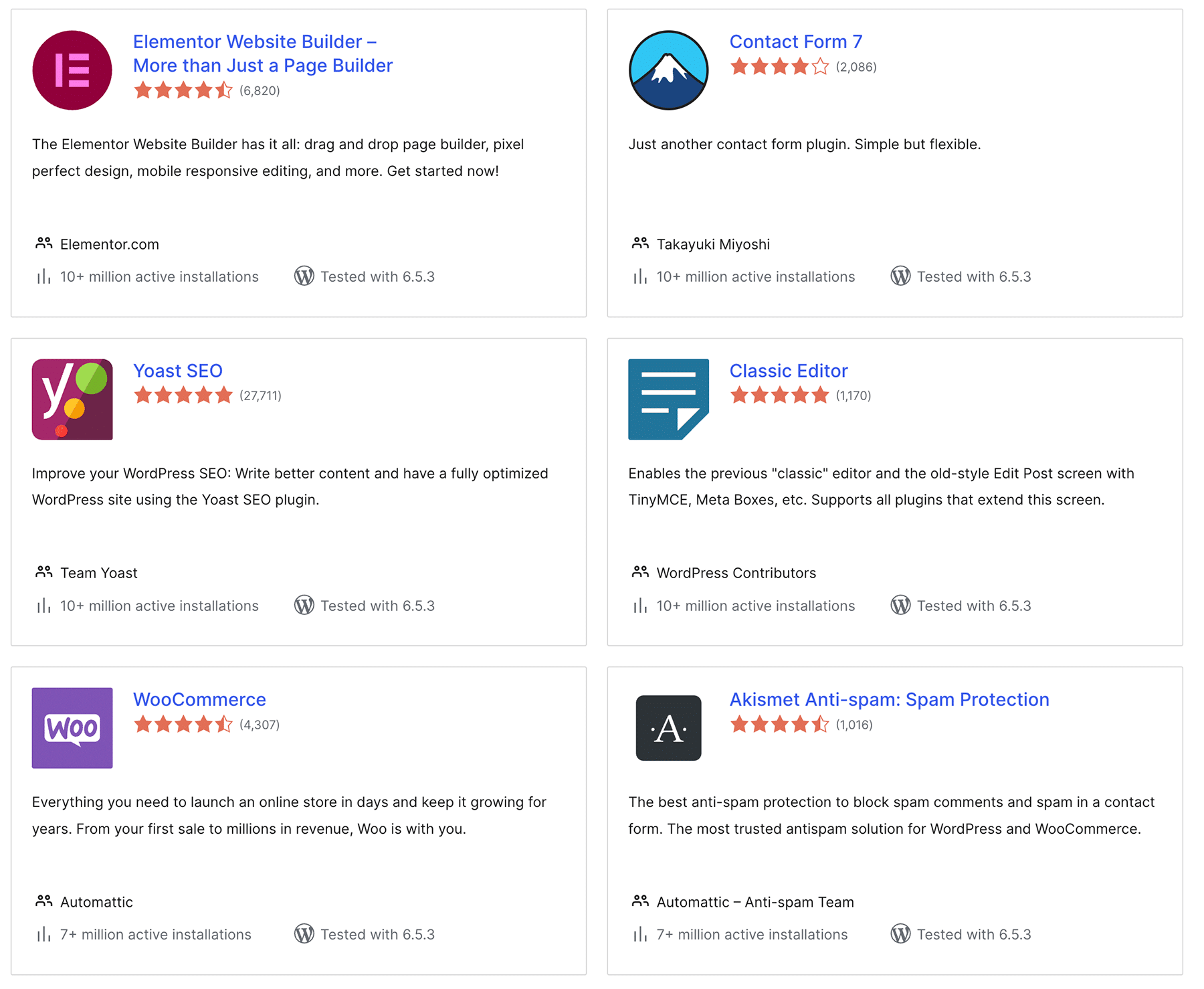
Besides Elementor, three other free plugins in the WordPress Plugin Directory with 10m+ active installs are listed below.
Top 10 free WordPress plugins by active installations*:
- Elementor Website Builder
- Contact Form 7
- Yoast SEO
- Classic Editor
- WooCommerce
- Akismet Spam Protection
- Contact Form by WPForms
- All-in-one WP Migration
- LiteSpeed Cache
- Wordfence Security
- Really Simple SSL
- Jetpack
*All of these plugins have 5m+ installations
The most popular paid plugin on CodeCanyon is Slider Revolution, which has been sold over 424,000 times to date. Below are some of the other best-sellers on the marketplace.
Top 10 premium WordPress plugins by number of sales (on CodeCanyon):
- WPBakery Page Builder – 405k
- UberMenu – 89k
- Ultimate Addons for WPBakery – 79k
- EventON – 62k
- Bookly Pro – 52k (Fastest growing)
- Essential Grid Gallery – 48k
- Popup Plugin – 41k
- Ultimate Membership Pro – 37k
- WordPress Automatic Plugins – 36k
- WooCommerce Amazon Affiliates – 35k
There is no way to tell how many paid users there are for plugins outside CodeCanyon. However, given the number of users for free plugins like Elementor and Yoast SEO, we can assume that they are even more popular than the premium offerings mentioned above.
Other interesting plugin statistics
Ilovewp carried out an analysis of over 18,000 plugins on the WordPress Plugin Database. Here are some interesting stats that came to light in the study:
- 18.3% of plugins have never been updated
- 68% of plugins have fewer than 100 active installations
- 57% of plugins have never been rated by users
- 28% of plugins have a perfect 5-star rating
- 47% of plugins have a link to a donation page
- Only around 2% of plugins have over 10k active installations
Sources: CodeCanyon, Ilovewp, WordPress Plugins Directory
WordPress version statistics
Next, we’ll examine some statistics that tell us more about the different WordPress versions people use and why.
Which version of WordPress do most people use?
62.4% of WordPress users use WordPress 6.5, making it the most used version. WordPress 6.5 is the latest iteration of the core WordPress software at the time of writing and was released in April 2024. It’s been downloaded 82 million times at the time of writing.
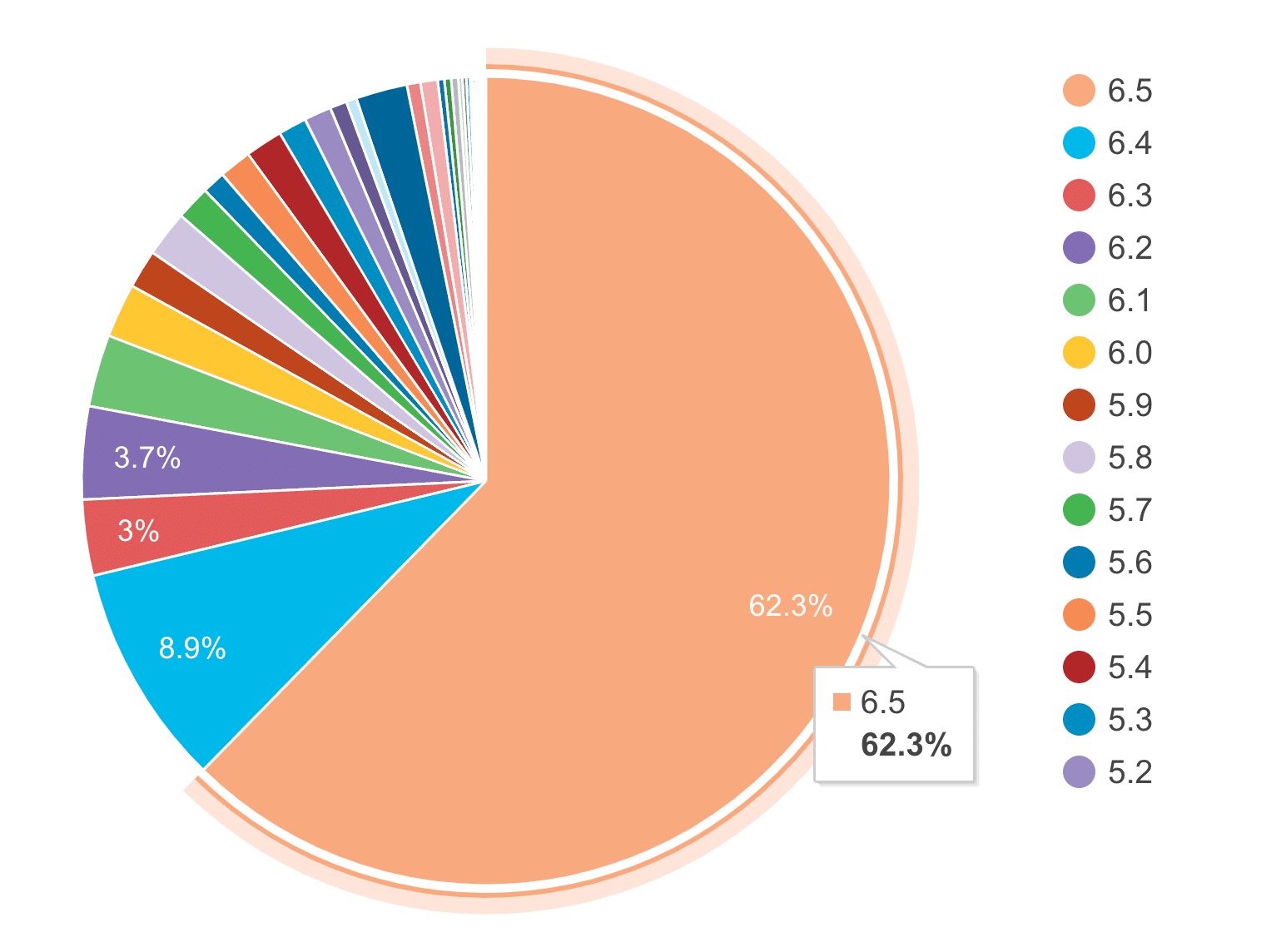
But while it’s true that most people are using the latest version of WordPress, this still means that only a little under half of all users are running outdated versions of the CMS. The problem with this is that failing to update to the latest version of WordPress is a security vulnerability that puts your website at greater risk of being hacked. Here is more information on how and why WordPress websites get hacked.
Top 5 WordPress versions by usage:
- 62.4% are using WordPress 6.5 (the current version)
- 8.9% are using WordPress 6.4
- 3% are using WordPress 6.3
- 3.7% are using WordPress 6.2
- 2.9% are using WordPress 6.1
As you can see, WordPress 4.9 is somewhat of an outlier in that despite several versions out of date, it’s still the 6th most used version.
This likely is because this was the last version of WordPress before the introduction of the block-based Gutenberg editor in WordPress 5.0. Presumably, those who continue to use version 4.9 prefer the old classic editor.
And speaking of Gutenberg…
Gutenberg by the numbers
Gutenberg has over 77.5 million active installations on WordPress and counting. Over 279 million posts have been written in the editor so far.
The Gutenberg WordPress editor uses a block-based system. Unsurprisingly, the most used block is the paragraph block, which accounts for 56.5% of all blocks used.
Top 10 most-used Gutenberg blocks:
- Paragraph – 56.5%
- Image – 14.7%
- Heading – 12.4%
- List – 4%
- Spacer – 3.3%
- Separator – 1.8%
- HTML – 1.5%
- Group – 1.4%
- Columns – 1.3%
- Button – 0.9%
How often does WordPress release updates?
WordPress typically releases a major update to its core software 2 to 3 times per year, around every 3-6 months.
These major updates represent new version releases and are named after jazz musicians (because apparently, WordPress developers are big jazz fans). The latest release was named after musician Arturo O’Farrill.
WordPress version history (release dates)
- WordPress 6.5 – April 2, 2024
- WordPress 6.4 – November 7, 2023
- WordPress 6.3 – August 8, 2023
- WordPress 6.2 – March 28, 2023
- WordPress 6.1 – November 2022
- WordPress 6.0 – January 2023
- WordPress 5.9 – January 2023
- WordPress 5.8 – January 2023
- WordPress 5.7 – March 2021
- WordPress 5.6 – January 2023
- WordPress 5.5 – January 2023
- WordPress 5.4 – March 2020
- WordPress 5.3 – November 2019
- WordPress 5.2 – May 2019
- WordPress 5.1 – February 2019
Sources: Gutenstats, WordPress stats, WordPress download counter, WordPress history
WordPress.com statistics
So far, all of the WordPress statistics we’ve looked at have been related to the open-source content management system available at WordPress.org.
Next, we’ll look at some statistics about the fully-hosted blogging platform, WordPress.com.
While WordPress.com uses the same WordPress core software, it’s fully for-profit and acts as a managed hosting platform that helps you to build and host your website. This makes it different from WordPress.org, a source where you can download the software.
How many blogs are published on WordPress?
WordPress.com users publish around 70 million new posts every month. That works out at around 1,600 new blog posts every minute or over 26 per second. In addition, there are over 77 million comments on WordPress blog posts every month.
How many people read WordPress blogs?
Over 409 million people view over 20 billion pages on WordPress.com websites monthly.
Who uses WordPress.com?
The statistics suggest that most WordPress.com users are English speakers as 71% of blogs are written in English. A further 4.7% are written in Spanish, making this the second most popular language for WordPress blogs.
Top 5 languages used on WordPress.com:
- English – 71%
- Spanish – 4.7%
- Indonesian – 2.4%
- Portuguese – 2.3%
- French – 1.5%
Sources: WordPress.com
WordPress WooCommerce statistics
Next, let’s take a look at some WooCommerce statistics. WooCommerce is an ecommerce solution built on WordPress. It’s built and owned by Automattic—the same company behind WordPress itself.
You can install and activate the WooCommerce plugin on your WordPress website to turn it into an ecommerce store and start selling products online.
How many WooCommerce stores are there?
According to our calculations, there are over 163.5 million WooCommerce stores online.
This is based on the fact that 8.7% of all websites use WooCommerce, according to W3Techs, and there are around 1.88 billion websites online.

Key WooCommerce usage statistics:
- 20.2% of all sites that run on WordPress use WooCommerce. This makes it the biggest subcategory of WordPress sites.
- The WooCommerce plugin has over 5 million active installations on the WordPress plugin database
- There are 771 official WooCommerce extensions. That includes 47 free extensions and 724 paid extensions
- WooCommerce stores generated over $10b in sales in 2017
WooCommerce market share
WooCommerce is the leading e-commerce solution with 36.68% of the global market share. That’s more than double its closest competitor, Squarespace Online Stores, which has just a 14.49% market share.
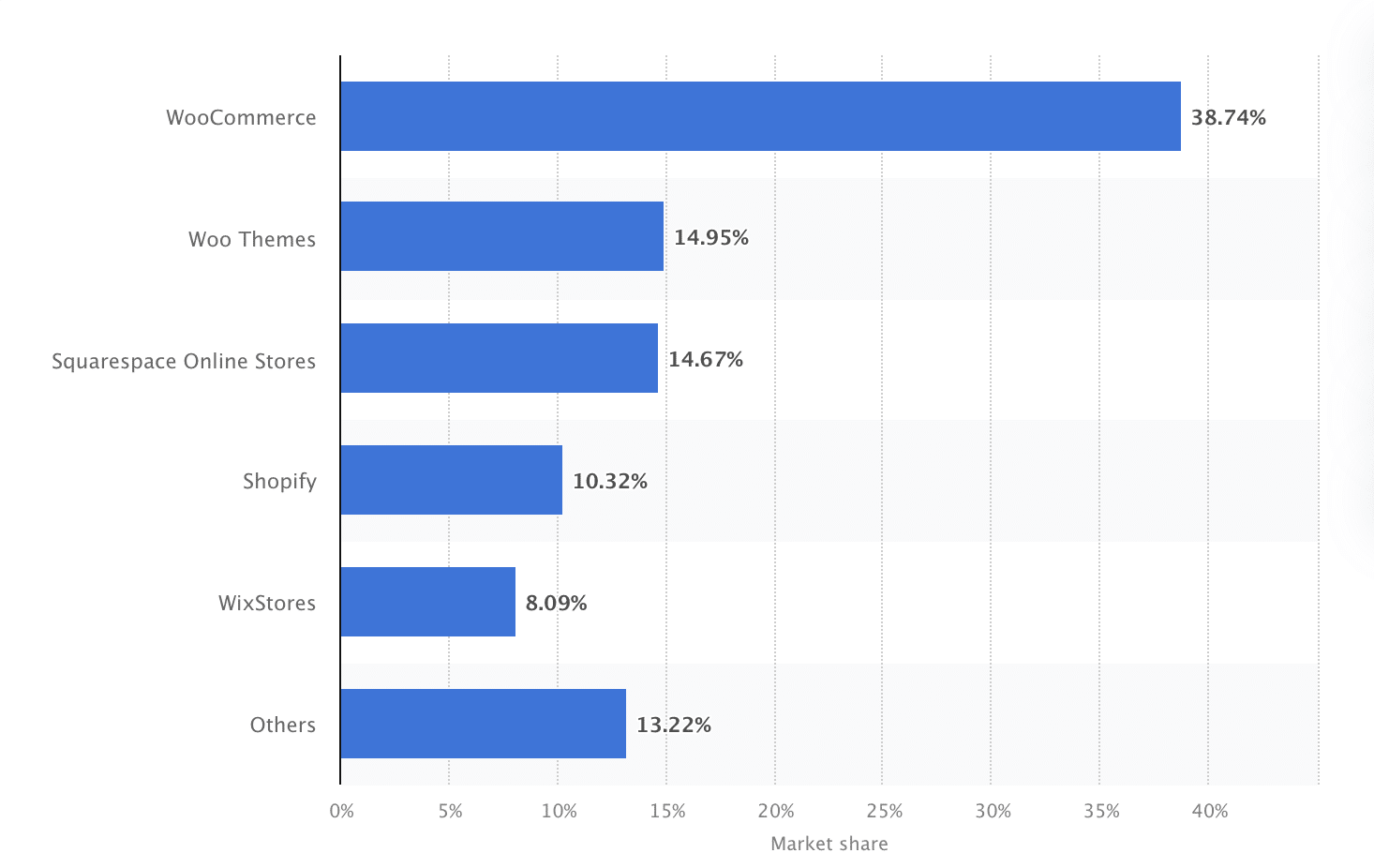
Top 5 ecommerce platforms by market share:
- WooCommerce – 38.74%
- Squarespace – 14.67%
- Woo Themes (Old version of WooCommerce) – 14.94%
- Shopify – 10.32%
- WixStores – 8.09%
Sources: W3Techs3, W3Techs4, WPTavern, WordPress plugins, Statista
Final thoughts: WordPress Statistics
That concludes our roundup of WordPress statistics. We hope you found these stats useful!
The key takeaway is that WordPress continues to lead the pack regarding CMS platforms. It’s still the most-used platform, but it shows no sign of slowing down.
Ready to start your own WordPress website? Check out our in-depth guide on how to get started here.
Looking for more data? Here are the most important social media statistics globally.
Good luck!








It’s weird to see the WordPress growth trend only +0.3% for 2023 while there was a lot of innovation and improvements happening this year. Do you think this will change for 2024?
Phil,
While the market share growth has slowed dow, WordPress still added tens of millions of new websites last year alone. It is now the coolest new tool that grows 10x a year but the growth trend is still there.